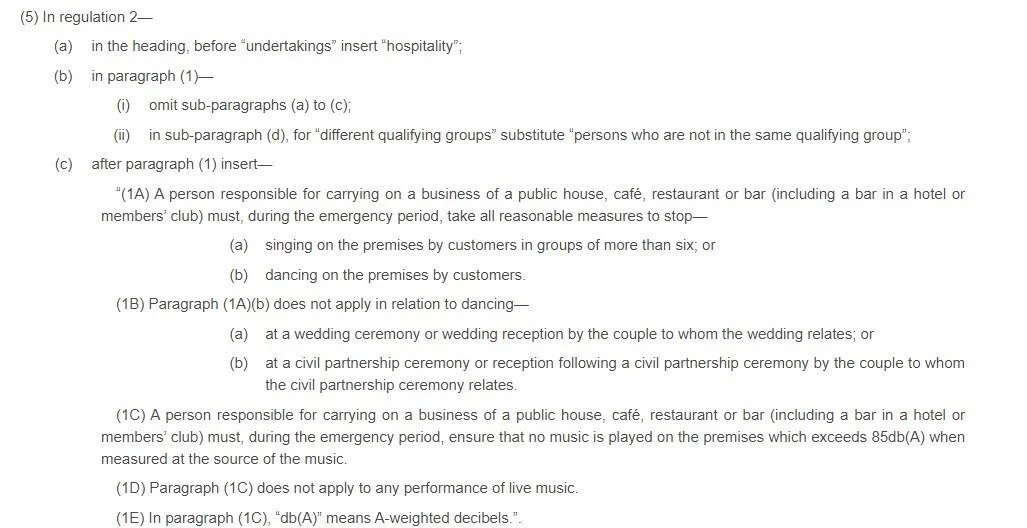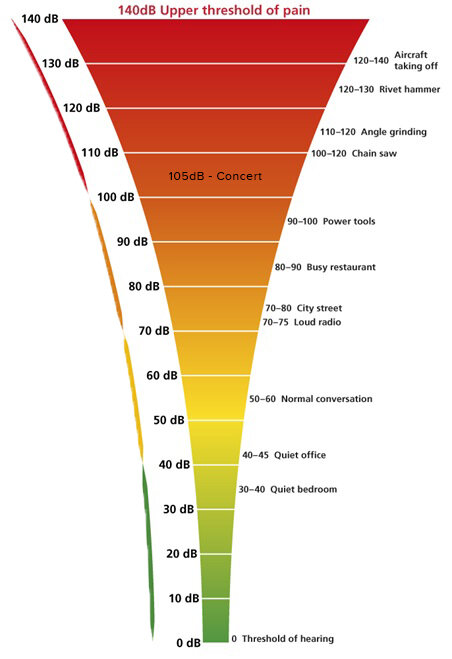What is a Sound Limiter?
This article is to help you understand how sound limiters actually work so you can ask the right questions to your venue and be able to decipher what the answers mean.
My venue has a sound limiter installed, how will this affect me?
What is a Sound Limiter?
A sound limiter measures the Sound Pressure Level of a room. It will have a set threshold in Decibels, if any noise or combination of noises exceeds the threshold for a given period of time then the power will be cut in that room. This could be anything from the music coming from the speakers, the noise from a drum kit or even the crowd cheering. They are designed to keep bands/DJs ‘under control’.
However when a venue tells you “the limiter is set at 90 decibels”, it doesn’t actually mean anything. There are several factors that can affect a sound limiter installed in a venue:
Over what period of time is the sound being measured?
How far away the measurement microphone is from the sound source (PA speakers & crowd are the source in this instance).
How the sound is actually being measured (the weighting or bias, does it compensate for human hearing?)
How does a limiter work?
Most sound limiters installed in venues will be the ‘cut-off’ type. These limiters have a light-up meter on the measurment device (going from green on the left to red on the right), this is attached to a microphone that will be located somewhere inside the room.
When the sound level rises above the threshold for a given period of time, the electricity supply will be cut to the room. Sound limiters can be affected by any ambient noise such as Music from a PA, instruments such as guitars or drums, people in a crowd cheering/shouting/talking or even fireworks outside of the room.
Some venues will have a ‘traffic light’ system to let the DJ/Band know when it’s too loud, others will have a member of staff with a sound meter who will gauge if it’s too loud and ask the performer to turn it down.
Footage of a limiter at its absolute maximum. Notice how you can clearly hear the small audience sing along over the music. Had I continued for another couple of seconds at this volume, everything including lights would have been cut off:
Sound limiter being triggered by fireworks that are going off a good while away:
How Loud is 85 Decibels, for example?
During the 2020 Summer, Bars/Restaurants in England were told to have music no louder than ‘background level’. The specific Decibel limit in these Bars/Restaurants was 85dBA at the source, this is what the UK government officially class as ‘background level’. A 10 Decibel increase is what humans perceive to be twice as loud, so 95dBA is 2x as loud as 85 dBA. Most limiters are set between 85-95dBA
The Science & Jargon
What is a decibel?
A decibel unit used to measure the intensity (or power level) of a sound. There are many many different types of decibels (dBA, dBC, dBZ, dBFS, dBu, dBw, dBm and more)
In our case we are referring to A-Weighted Sound Pressure Level (dBA or dB SPL for short). This is a measurement of the intensity of the sound weighted to compensate for human hearing.
How is SPL measured?
SPL must be measured 3 different ways.
Over a specified period of time
From a specified distance
Over a specified frequency spectrum (this affects how sensitive it is to bass)
Is 100dB twice as loud as 50dB?
No, Decibels are a logarithmic measurement, not a linear measurement. For simplicity’s sake, a 6dB difference is what makes a sound twice or half as intense (or loud).
As an example:
Twice as loud as 50dB is 56dB, twice as loud as 56dB is 62dB etc.
Half as loud as 50dB is 44dB, Half as loud as 44dB is 38dB etc.
In Summary
Before you end up boring yourself below. Here’s what you need to know:
Sound limiters will generally measure ‘Peak’ SPL, this means ‘fast’ loud noises such as a drum can trigger them. This is a bad thing.
Each time you double your distance from the sound source, you ‘lose’ 6dB SPL. If a sound limiter’s measurement microphone is placed over the dancefloor right front of the speakers and directly above the crowd, it will cut off a lot earlier than if it is placed at the back of the room 10m away (The noise will have to be over 4x as loud for the music to cut off for the 10m away limiter). This is the case even if both thresholds were set at 90dB.
Sound limiters will generally compensate for human hearing & are less biased towards bass. This is a good thing however, some don’t!
Learn the difference below…
Decibels over time
Sound pressure levels can be measured either Peak, RMS or Leq.
Peak is a constant instantaneous measurement.
RMS is a continuous average.
Leq (sometimes written as LAeq) is an average over a long period of time (generally 15 minutes; written as Leq15 or LAeq15).
Unfortunately, Sound Limiters installed in venues will generally measure ‘peak’ SPL meaning short loud sounds such as a snare drum or people cheering will send the limiter into the ‘red’ and cut off electricity to the stage.
Rock concerts in Europe are generally limited to anywhere between 95-107dB Leq15 at the sound desk (40m-50m from stage) meaning the sound has to average that figure over 15 minutes so small peaks from a snare drum won’t affect the overall level.
What difference does this make in real terms?
Generally speaking, for recorded music playback a peak measurement will appear 6-12dB higher than the RMS level on the same meter. 96dB SPL Peak will be 84-90dB SPL RMS.
The difference widens for live music (if you have a live band, a snare drum can peak at 120dB but the overall RMS level of the band may be around 95-100dB). Wedding/Function bands will generally switch to an electric drum kit to allow the dynamic range to be controlled and reduce the difference between the peak & RMS levels.
Decibels over distance
If you can think of a speaker like a lightbulb or a torch. (For simplicity’s sake) Low frequency sounds (bass) are omnidirectional like a bare lightbulb, great for filling a room with light but useless at focusing in on one narrow spot. High frequencies (mid and treble) are more like a focused beam from a torch & will travel further inside the room. However, Bass frequencies will travel through solid surfaces such as walls, windows etc. This is where most noise complaints start.
Why is that relevant?
In the sound world, any single object omitting an omnidirectional sound is known as a ‘point source’.
According to theory, each time you double your distance from a point source, you will lose half the intensity (6dB SPL).
For example: If a speaker is recorded at 100dB SPL at 1 meter, it will be 94dB at 2 metres, 82dB at 8 metres and so on....
This is because the sound is concentrated in a smaller area the closer you are to the speaker.
If the microphone for the sound meter is closer to where the PA is located, a lot less SPL headroom will be available.
This is known as the ‘inverse square law’
Ignore the numbers on this one, it’s just there to demonstrate how a light will become less intense as you get further away as it is spread over a wider area.
So how loud actually is 90 dB SPL?
Sitting in a busy pub/restaurant (150-200 people) with everyone having a conversation will typically sit between 85-96dB. Think about the bar area of The Counting House in Glasgow on a Friday afternoon.
90dB (RMS) is about as loud as a hairdryer measured from 1 meter.
A rock concert measured from 40m is usually around 115dB peak. As mentioned above, Rock concerts in Europe are generally limited to anywhere between 95-107dB Leq15 at the sound desk (40m-50m from stage). This will allow the engineer to ‘build up the set’ really slowly. For a 30 minute set it’ll likely come in loud for the first 2 songs then quieten for the next 2 (say 3.5 min per song plus a minute’s talking in-between), the second half will start off quiet and build up for the last 2 songs so the act can go out with a bang.
A sound limiter set to cut off at 90dBA (Peak) 8m away from the performing area will generally allow the DJ/Band to play at around 80-84dBA (RMS). That’s far quieter than the average you’ll hear at a concert and not much above talking level.
Decibels over a given frequency response (how sensitive is it to bass frequencies)
Sound meters can be set to measure using A, C, and Z frequency weightings. A weighted measurements compensate for the human ear’s frequency response (how the ear actually hears things at different levels). C weighted is flat response but takes into consideration the limits of human hearing (20Hz-20Khz), Z is completely flat.
What does that mean?
‘A weighted’ measurements are less biased towards bass frequencies, C and Z are more biased.
The good news is that most Sound Limiters will be set to measure ‘A weighted’ sound which means they don’t register as much in the low frequency region (similar to human hearing). This means the DJ/Band will be able to play adequate levels of bass through their speakers without worrying about the limiter cutting off. This ensures the sound remains balanced and won’t become harsh, tinny or ‘in your face’ sounding.
A weighted Decibels are represented as dBA or dB(A).
If your venue has a ‘C weighted’ limiter and tell you it’s set to cut off at 90dBC, this can equate to as low as 65dBA (as loud as a face-to-face conversation between 2 people). The Waterside’s Limiter is a great example. Set to 95dBC which equates to less than 69dBA when converting at 63Hz (a bass frequency).
This is bad.
See where 69dB lands on the graphic above. Quieter than a city street, bearing in mind your venue (without music) will be as loud as a busy restaurant purely with people having a conversation.
Any C weighted limiter should be set at least around 110-125dB. The West Brewery’s C weighted limiter is set to 120dBC (which equates to around 95dBA and is more than adequate to create an atmostphere)
Below is a graph showing what different weightings pick up across the frequency spectrum. Human hearing is limited from 20Hz to 20000Hz
Look at the difference in curves in the sub-bass and bass regions, ‘A weighted’ shows bass & sub-bass frequencies having between a 10dB and 50dB difference for the same signal.
A weighting & C weighting are equal at 1000hz (1Khz).If you were playing a 90dB tone & were measuring both A & C weighted SPL, both meters would show 90dB
However, there’s a 25.4dB difference at 63hz meaning 90dB A weighted would read 115.4dB C weighted. There’s around 35dB of a difference at 40hz (a standard bass guitar instrument found in every band can go as low as 41hz, most modern music will go down below 30hz) and the gap gets wider the closer to 20hz you go.
And a little bit of fun…
Still looking for a DJ for your event? Feel free to take a look around or enquire here






